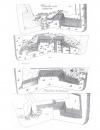Abstract
A good deal of the treatises on military architecture and engineering printed and published in Europe along the 16th, 17th, and 18th centuries constituted a means of transmitting technical knowledge closely related to the construction of the most important parts of fortified premises. Such as foundations, walls, arches, and vaults were a constant preoccupation for Italian, French, and Spanish authors, giving rise to numerous construction solutions that ranged from aspects such as knowledge of materials and the labor related to the execution, to the control and administration of the construction itself. This article describes some of that knowhow, starting from a detailed revision of the most important writers on fortifications. These were consulted through a rigorous research endeavor, including an explanation on the manner in which, from the American territory, some contributions were made to European military engineering. Although no direct reference is made of constructed examples, the article contributes with ideas to architects dedicated to monumental restoration on the way the technique was conceived, in its broader conception, by military engineers and architects who intervened in the tracing and construction of fortifications.Apuntes is registered under a Creative Commons Attribution 4.0 International Public License. Thus, this work may be reproduced, distributed, and publicly shared in digital format, as long as the names of the authors and Pontificia Universidad Javeriana are acknowledged. Others are allowed to quote, adapt, transform, auto-archive, republish, and create based on this material, for any purpose (even commercial ones), provided the authorship is duly acknowledged, a link to the original work is provided, and it is specified if changes have been made. Pontificia Universidad Javeriana does not hold the rights of published works and the authors are solely responsible for the contents of their works; they keep the moral, intellectual, privacy, and publicity rights.
Approving the intervention of the work (review, copy-editing, translation, layout) and the following outreach, are granted through an use license and not through an assignment of rights. This means the journal and Pontificia Universidad Javeriana cannot be held responsible for any ethical malpractice by the authors. As a consequence of the protection granted by the use license, the journal is not required to publish recantations or modify information already published, unless the errata stems from the editorial management process. Publishing contents in this journal does not generate royalties for contributors.


